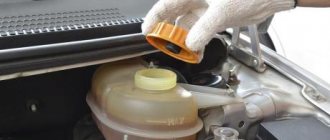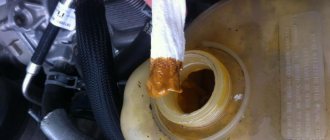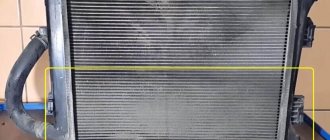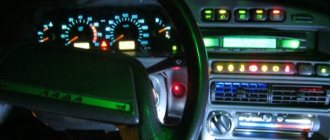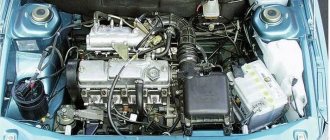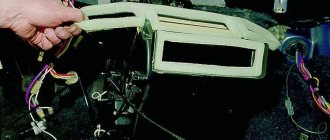If the antifreeze in the expansion tank begins to foam, then the problem is either in the cooler itself, or in the cylinder head gaskets and the block itself. In the first case, they sold you not a high-quality product, but an outright “mash” that was bottled somewhere in a warehouse independently.
The second option is the banal wear of gaskets that have served their purpose. The rubber bands no longer provide proper compression and begin to “blow out”. Although the reason may lie in the cylinder itself, in this case more serious intervention is required. The third reason is the systematic development of the second, or rather its serious consequences.
Briefly about the cooling system and antifreeze function
To approach the issue competently, you need to understand what role the coolant plays in the car’s cooling system.
So, antifreeze is designed for effective cooling of various internal combustion engine components. Antifreeze contains polyhydric alcohols, various additive packages, water and dye. This set of components allows the liquid not to freeze at low temperatures. The liquid was specially created so that car enthusiasts could have peace of mind in the cold winter. Antifreeze moves through the system via a pump.
Due to circulation, the operating temperature of the engine is maintained even in extreme conditions. Do not underestimate the role of coolant in the proper operation of a car. Antifreeze requires periodic replacement. It is very important.
Thermostat malfunction
A faulty thermostat can cause air in the coolant and foam in the radiator. Under normal operating conditions, the thermostat must open fully to ensure a smooth flow of coolant. They must also close to allow the antifreeze to heat up quickly during cold engine starting conditions. If the thermostat mechanism gets stuck in the open or closed position, then this will lead to overcooling or overheating, respectively. A faulty thermostat may open and close spontaneously, foaming the fluid and causing bubbles in the radiator and expansion tank. Rapid opening and closing of the thermostat valve will cause noise inside the radiator because the liquid will flow in uneven bursts.
Poor quality antifreeze
It was discussed above that antifreeze has a special composition that ensures effective engine cooling. The liquid is designed to protect the components and parts of the internal combustion engine from temperature deformations. Due to its formula, the coolant does not freeze even in severe frost.
If antifreeze foams in the tank, then first of all you should make sure that the product is of high quality. The liquid must circulate throughout the cooling system and all important key components constantly and even while the engine is warming up.
If you fill in a low-quality product, the principles of fluid circulation will not change, but the air that is in the expansion tank will react with elements from the coolant. As a result, the liquid will begin to bubble. Coke and foam are formed.
It often happens that you can see a brown mass in the tank. This is a signal that the antifreeze is of poor quality, was not manufactured using factory technology, but was diluted in the garages of would-be businessmen.
In addition, if they want to save money, sometimes drivers mix two types of incompatible liquids. Antifreeze also foams due to the fact that the liquid poured in is not the one recommended by the car manufacturer.
Problems in the cylinder block and the appearance of foam
This outcome is the most terrible for the driver. Only a major overhaul of the functional unit can help here. You can replace the part, but you will have to install not only the BC head, but also the entire block.
The reason for the breakdown is quite banal. A violation in the condition of the gasket leads to overheating and provokes the appearance of cracks, into which the resulting foam is subsequently poured. The cost of major repairs of such damage can be 30-50% of the price of the car, so it is not recommended to delay in solving the problem.
Gasket wear
Many people do not pay much attention to cylinder head gaskets, thinking that it is an insignificant part in a car that simply exists. But such a minor detail can add problems to the driver. If the gasket fails, the driver grabs his head and rushes to the service station at great speed.
In fact, the gasket plays an important role. Let's look at why antifreeze foams in the expansion tank. What problems does this rubber band solve? It prevents moisture from entering the block head into the block itself. When the gasket fails, liquid and free air pass into the expansion tank.
If we add high temperature to this, then remembering the laws of physics, we can conclude: foam will form. It does not appear immediately and in small quantities. If you do not solve the problem immediately, then bubbles will subsequently grow, and then the coolant will turn into a foamy mass. All this will be accompanied by smoke and temperature changes. The car will show normal temperatures.
Results
As practice shows, trying to save 99% on antifreeze turns into a serious problem. Some people allow it out of ignorance. Others, guided by the principle “nothing will happen if I fill these 2 bottles,” understand the mistake only after a while, when they shell out a round sum for engine repairs and a complete replacement of a radiator clogged with sediment that cannot be cleaned.
Make it a rule to do a scheduled inspection of the expansion tank every week for the presence of foam . The process is gradual, so timely detection of the problem will avoid serious consequences. Systematically monitor the quality of the antifreeze being poured. Ask experienced car owners with the same car where they purchase the cooler. You can save on washing, but not on consumables - it will cost more.
Coolant replacement
This will help if the antifreeze foams in the expansion tank and the liquid itself does not meet the declared characteristics.
First of all, open the stove tap - it’s not difficult to find. It is located inside the car. This is the same tap that regulates the temperature of the heater. The “hottest” position – the tap will be fully open.
Then unscrew the cap of the expansion tank or the filler part on the radiator. Next, you need to drain the liquid from the system - on many cars there is a special tap at the bottom of the radiator for this. If there is none, then the channel is closed with a plug bolt. You should prepare a container for the coolant - do not pour it into the ground. The liquid is drained completely, not forgetting to remove the intake manifold hose - this will help protect against the formation of air locks.
After this, new coolant is added. The manifold hose is installed back and the clamp is tightened. The liquid is poured into the tank or radiator to an average level. If necessary, the level is adjusted. As the temperature rises, the liquid tends to expand. Therefore the level may increase.
Start the engine and warm it up to operating temperature. Only now can you check the fluid level in the tank. If necessary, add coolant. This completes the process and the problem should no longer appear.
Causes of malfunction
When antifreeze boils, the reasons for this phenomenon may be different. Experienced motorists are well aware of them. The most common:
- low level of coolant in the expansion tank;
- a malfunction in the thermostat;
- clogged radiator.
In any of these cases, the antifreeze is not able to cool quickly. His temperature is constantly rising. When this indicator reaches 120 degrees Celsius, the boiling process begins. This leads to a situation where the antifreeze begins to boil away.
Ethylene glycol is the main component of any coolant. This substance is a chemical compound that belongs to the group of alcohols. It is its presence that ensures the liquid state of the product in the cold. When it boils, the process of evaporation of ethylene glycol occurs. The main danger of this process is that the vapors of the substance are toxic and pose a serious threat to the human nervous system.
Low antifreeze level
If a car owner is faced with a problem such as antifreeze boiling on a VAZ-2114, then he first needs to check the level of technical fluid in the tank. However, this procedure should be carried out only after the antifreeze has completely cooled. If a deficiency is detected, then, depending on the situation, the following manipulations must be performed:
If antifreeze has not been poured into the cooling system for a long time, it could simply leak out. If the level is low, it is necessary to top it up to bring the amount of technical fluid to the required level
When this is done, you can continue moving.
In a situation where antifreeze was recently poured into the cooling system, and its level dropped to a critically low level, it is necessary to pay attention to the structural integrity of the tank. You should also inspect all pipes, as well as hoses and clamp connections for technical fluid leaks.
If a leak has been discovered, and there is no way to solve the problem right on the spot, then you need to use the service of a tow truck and drive to the nearest car service center.
Thermostat failure
As part of the cooling system, the thermostat acts as a device that regulates the temperature of the antifreeze. It is thanks to it that accelerated heating of the power unit is ensured. This device also allows you to maintain the required thermal conditions during its operation.
When the thermostat breaks down or the valve simply gets stuck in one position, the large circuit stops working. In such cases, antifreeze circulates only in a small circle. However, this does not allow it to cool completely. To determine if this part is broken, you need to turn off the engine and then open the hood
You should find the thermostat pipes and touch them carefully to avoid getting burned.
If the pipe connected to the main radiator is hotter than the others, this may indicate some kind of problem with the operation of the device. In this situation, the most reasonable solution is to travel to the nearest service station to replace the device.
Even with such a malfunction, you can continue moving further, but at low speed. In this case, every 5 km you should stop and perform the procedure of adding water to the expansion tank. But this operation can be carried out only after the power unit has cooled. Then you can easily get to the service center and replace the faulty device.
Radiator problems
Antifreeze boiling can also occur if the radiator stops working. This malfunction may occur in the following cases:
- During operation, a layer of scale may appear on the tubes of the product. This leads to the fact that their thermal conductivity is noticeably reduced. When the number of clogged pipes increases, the ability of the radiator to cool the antifreeze passing through it decreases.
- There is dirt in the radiator or the tubes are completely clogged. If such a problem occurs, it leads to a decrease in coolant circulation. In advanced cases, this process stops altogether. As a result, the temperature of the antifreeze increases - it boils.
- A problem with the radiator can also arise if the fan fails. Then the product does not have the ability to cool the antifreeze to the required temperature. The car owner can independently determine that the malfunction occurred in the fan. This can be done by ear. If the car engine is quiet when starting, it means it is not turned on.
Replacing the cylinder head gasket
The procedure for replacing an engine gasket is actually not complicated. Leaks form where the cylinder head connects to the cylinder block. Why does antifreeze foam in the tank? The reason is overheating. In this situation, the structure and the tightness of the gasket are compromised. It is impossible to delay in eliminating such a malfunction.
The gasket changes almost the same on different cars. There are differences in the procedure for dismantling the fasteners. It is worth knowing the tightening torques of the bolts.
To prevent possible disruption of the fastener structure and failure of components and elements, the bolts are thoroughly cleaned. Before unscrewing them, remove excess dirt. If this is not done, then if it breaks, there may be problems with unscrewing.
The bolts are unscrewed as evenly as possible. It is recommended to weaken them from the center. After each bolt is completely loosened, remove the head and change the gasket. To ensure proper installation of the gasket, there are alignment bolts on the block.
Prevention measures
Any repair is easier to prevent than to carry out. It doesn’t matter what kind of car the owner has - Nexia or Zhiguli. Any car requires care. It is necessary to regularly buy and change coolant. There is no consensus among car enthusiasts about which raw materials are better: domestic or foreign. The main thing is to give preference to well-known brands. The procedure can be performed at a car dealership or independently.
Replacing the gasket becomes more and more difficult, since it is impossible to determine by eye when it is leaking. If any problems occur (smoke, foam, temperature changes), it is important to immediately contact a car repair specialist. You should not operate the machine until the problems are fixed, otherwise there is a risk of aggravating the breakdown and increasing the cost of repairs.
Regular preventive inspections will help extend the life of your car. It is better to contact branded centers that are recommended by manufacturers. They guarantee highly qualified employees. Inexperienced craftsmen can only do harm.
Coolant leaking from the reservoir
This is another problem that raises many questions among car owners. What contributes to this? There may be several reasons for this. However, the most important one is a worn-out cooling system. When the engine is running, the pipes and hoses experience strong pressure from hot antifreeze, so during prolonged operation the tank will push out the liquid rather than distribute it throughout the system.
But the problem does not only appear on used cars. The cause may be a faulty expansion tank. This is due to the low quality of spare parts or defects. If there are burrs on the neck of the tank, this indicates that the lid does not close tightly and coolant will splash out through the gap.
Another reason is substandard plastic of the tank. Low-quality material cannot withstand pressure and tears at the seams. In this case, the coolant is poured onto the engine and the entire engine compartment.
What does foaming mean?
If bubbles appear near the expansion tank or foam is visible in the antifreeze, this may mean that an unwanted chemical reaction has occurred or it has mixed with liquids that it should not mix with. Normally, the refrigerant should not foam: this always indicates a malfunction or poor quality of the original liquid, but breakdowns do not always require expensive corrections. Sometimes the solution may be to simply replace the cooler and flush the cooling system. In other cases, diagnosis and repair may be necessary.

